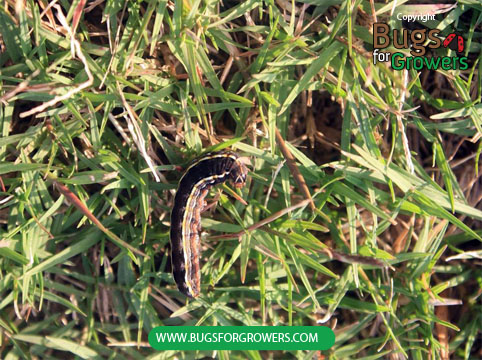What are Fall armyworms?
The larvae of Spodoptera frugiperda are called as the fall armyworms because they always occurred in the fall season and march in groups like an army and destroy different crops and pasture. The fall armyworms vary in color from light tan or green to black with several different colored stripes on their body and a distinctive “Y” shaped mark on their heads between their eyes (Photo 1).
Photo 1. The larva of the fall armyworm with a distinctve “Y” shaped mark on its heads between its eyes.
How the fall armyworms cause damage to pasture?
Immediately after hatching from eggs, the small larvae of the fall armyworms start feeding on their hosts like corn, various types of turfgrasses and pasture. The damage caused by the first, second, third and fourth larval stages does not appear very severe because they do not consume leaves as much as their mature stages can consume. However, as the development of larvae progresses into fifth and sixth stages, they start consuming large amounts of leaves causing very prevalent and severe damage to pasture. This damage appears overnight because the fall armyworms are actively feeding on pasture during night time but hiding under thatch during daytime,
Combating of the fall armyworms with beneficial entomopathogenic Steinernema carpocapsae nematodes
There are several naturally occurring enemies like parasites, predators, pathogens and beneficial nematodes can attack and kill many fall armyworms but most of the time they are not enough to combat the fast growing populations of fall armyworms. Therefore, the populations of naturally occurring enemies can be supplemented with commercially grown biological control agents like beneficial entomopathogenic Steinernema carpocapsae nematodes.
What are beneficial Steinernema carpocapsae nematodes?
Beneficial entomopathogenic Steinernema carpocapsae nematodes are microscopic worms (Photo 2) that are currently used as successful alternatives to chemical pesticides for controlling many insect pests including armyworms because they are not harmful to pets and humans. They are also easy to apply and can kill armyworms within 48 hours after their application.
Photo 2. Infective juveniles of Steinernema carpocapsae nematodes
How beneficial entomopathogenic Steinernema carpocapsae nematodes can kill fall armyworms?
When Steinernema carpocapsae nematodes are applied to the pasture fields, they will actively search for all the soil-dwelling larval and pupal stages of fall armyworms. After locating larva or pupa, nematodes will enter into their body cavity through the natural openings like anus, mouth and spiracles. In the body cavity, nematodes will release symbiotic bacteria (Xenorhabdus nematophila) in the blood where bacteria will multiply quickly, cause septicemia and kill both larva and pupa within 48 hours of infection. Thus the killing of both larvae and pupae completely stops the emergence of next generation of adult fall armyworms.
How to apply Steinernema carpocapsae nematodes?
Depending upon the size of fall armyworm infested areas to be treated, apply Steinernema carpocapsae nematodes using a water can for small area (Photo 3) and a Knapsack sprayer for large area. Since nematodes need a film water for their easy movement in the soil, irrigate areas to be treated before and after the application of nematodes so that there will be an optimum level of moisture in the soil for nematodes to move freely in the soil profile to seek their host. Also, apply nematodes either early in the morning or late in the evening to avoid their exposure to UV radiation as its short exposure can kill them instantly.
Photo 3. Use water can to apply beneficial Steinernema carpocapsae nematodes
How many Steinernema carpocapsae nematodes should be applied?
The optimum rate for the effective control of armyworms would be 23,000 Steinernema carpocapsae nematodes per square foot area. Use the following table for applying appropriate rates of nematodes to cover specific sizes of fall armyworm infested areas.


